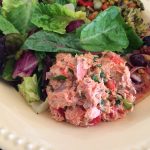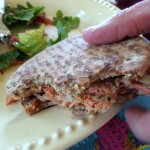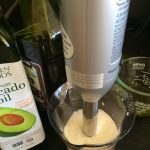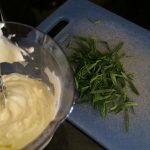Salmon Salad for Summer
It’s no secret. I love to cook. But like most people, I don’t always have time for it.
The popularity of processed food is evidence that many struggle with getting a home-cooked meal on the table. Half of Americans say they value processed foods because they’re convenient, stay fresh longer and are affordable. (Reference 1).
With some exceptions, I prefer the quality of home-cooked food over frozen and ready-made options. My strategy to streamline kitchen prep time is “planned overs.”
In other words, cook something once and incorporated it into two or three meals. In the summer I take advantage of the availability of fresh salmon and other fish so I purchase enough for two or three meals, maybe a whole fish or several filets. I’ll grill the entire amount one evening and serve it fresh.
I use the rest to make another meal such as Salmon Burgers
which can be frozen and pan-fried as needed. This week it was too warm to stand over a stove or grill, so I made the following Summer Salmon Salad., too
This strategy of “planned overs” makes it easy to meet seafood consumption recommendations,too. Both the 2015-2020 Dietary Guidelines for Americans and the American Heart Association recommend consuming at least two seafood meals each week, a total of about 8 ounces for adults, to prevent cardiovascular disease. (References 2, 3). There may be other benefits. Eating patterns that include seafood may be associated with reduced risk of obesity. Seafood consumption among women who are pregnant or breast feeding, is associated with better infant health outcomes (Reference 2).
It’s wise to eat a variety of seafood, especially types rich in omega-3 fatty acids such as salmon, sardines, anchovies, herring, shad, Pacific oysters, trout and Atlantic and Pacific mackerel. Read “The Lowdown on Essential Omega-3 Fatty Acids” (Reference 4) for more information on omega-3 fats. Note that a variety of fish, such as halibut, cod or rockfish can be used instead of salmon in the Salad and Burger recipes.
Ever since I discovered David Liete’s easy “milk mayonnaise” (Reference 5) which uses cold milk instead of raw egg yolk to emulsify the ingredients, I make homemade mayonnaise often. I always have milk in my fridge and prefer not to use raw eggs for food safety. It’s much tastier than jarred mayonnaise, especially in the Salad.
When you make your own mayonnaise, you can use your favorite top quality oils such as grapeseed, extra virgin olive or avocado oil. I use about 2/3 avocado and 1/3 olive oil. I find it economical, too, as avocado mayo sells for nearly $12.00 a jar. Even Hampton Creek’s gluten-, egg and soy-free Just Mayo product made with pea protein is in that price range.
“Milk Mayonnaise” can be whipped up with an immersion blender and the basic recipe can be varied with herbs (the photo shows my tarragon mayonnaise),
citrus zest and other flavorings. In addition to using it as an ingredient and sandwich spread, you can use it as a sauce to enrich lean grilled seafood or chicken breasts.
Summer’s Best Salmon Salad
One hardly needs a recipe for a salmon salad – consider this a suggestion. Elevate it into something special with homemade herb mayonnaise and jalapeno-stuffed olives as I did, or your own favorite condiments.
Serves 4 to 5.
½ cup mayonnaise
½ cup finely chopped red bell pepper or red radishes
1/3 cup finely chopped fresh basil or parsley
1/3 cup finely chopped jalapeno-stuffed olives
1/3 cup thinly sliced green onion or chives
2 tablespoons olive oil
2 tablespoons lemon juice
1 tablespoon drained capers
1 heaping teaspoon lemon zest
4 cups cooked, flaked salmon (bones and skin removed)
Salt and freshly ground pepper, to taste
- In a large bowl combine mayonnaise, bell pepper, basil, olives, green onion, olive oil, lemon juice, capers and zest. Stir to blend well. Stir in salmon. Taste and add salt and pepper to taste. Cover and chill for one hour before serving. Serve with greens, on toast or flatbread.
- IFIC What’s Your Health Worth? Food & Health Survey 2015. Accessed March 17, 2016.
- The American Heart Association’s Diet and Lifestyle Recommendations. American Heart Association website. Accessed April 29, 2016.
- The Lowdown on Essential Omega-3 Fatty Acids in the Diet by Marisa Moore, MBA, RDN, LD. Foodandnutrition.org. December 18, 2015
© 2016 Lorelle Del Matto




 About lorelle
About lorelle
Speak Your Mind